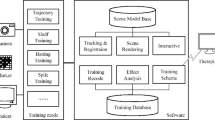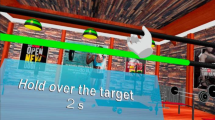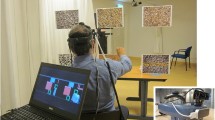Abstract
Stroke patients or victims who have been involved in serious accidents often suffer from impaired hand-eye coordination and muscle dexterity. Products, such as nine-hole pegboards, have been designed to help rehabilitate various skills, e.g., perceptual accuracy and finger dexterity. Patients who do not have sufficient muscle strength would not be able to carry out such traditional exercises. This paper presents the research aims at providing a fresh and viable approach to physiotherapy for such patients while emulating the rehabilitation capabilities of traditional products. In this paper, a novel approach, AR-Rehab, for the rehabilitation of hand-eye coordination and finger dexterity has been developed incorporating Augmented Reality (AR) technology. In this application, the users can interact with virtual piano keys in a real-life scene by moving the real hands wearing data-gloves to detect the flexing of the fingers and markers to detect the position of the hands.







Similar content being viewed by others
References
Adamovich SV, Fluet GG, Mathai A, Qiu Q, Lewis J, Merians AS (2009) Design of a complex virtual reality simulation to train finger motion for persons with hemiparesis: a proof of concept study. J NeuroEng Rehabilitation 6(28). doi:10.1186/1743-0003-6-28
Aguiar R, Piano VR (2007) Available from: http://www.youtube.com/watch?v=wdDxXdMOKX0. Accessed: 28th Aug 2009
ARToolKit (2010) [online] Human Interface Technology Laboratory, University of Washington. Available from: http://www.hitl.washington.edu/research/shared_space/download/. Accessed 12 June 2010
Barakonyi I, Schmalstieg D (2005) Augmented reality agents in the development pipeline of computer entertainment. In: Proceedings of the 4th International conference on entertainment computer, Sanda, Japan, 2005 September 19–21, pp 345–356
Broeren J, Bjorkdahl A, Claesson L, Goude D, Lundgren-Nilsson A, Samuelsson H, Blomstrand C, Sunnerhagen KS, Rydmark M (2008) Virtual rehabilitation after stroke. StudHealth Technol Inform 136:77–82
Burdea G, Popescu V, Hentz V, Colbert K (2000) Virtual reality-based orthopedic telerehabilitation. IEEE Trans Rehabilitation Eng 8(3):430–432
Burke JW, McNeill MDJ, Charles DK, Morrow PJ, Crosbie JH, McDonough SM (2009) Serious games for upper limb rehabilitation following stroke. 2009 Conference in games and virtual worlds for serious applications, Coventry, UK, March 23–24, pp 103–110
Chen Y, Huang H, Xu W, Wallis RI, Sundaram H, Rikakis T, Ingalls T, Olson L, He J (2006) The design of a real-time, multimodal biofeedback system for stroke patient rehabilitation. In: Proceeding of the 14th annual ACM international conference on Multimedia, ACM Press, New York, Santa Barbara, CA, USA, 2006 October 23–27, pp 763–772
Choi KS, Chow CM, Lo KH (2010) A rehabilitation method with visual and haptic guidance for children with upper extremity disability. Lecture Notes Comput Sci 6180/2010, 2010, 77–84
Crawford JD, Medendorp WP, Marotta JJ (2004) Spatial transformations for eye–hand coordination. J Neurophysiol 92(1):10–19
Crosbie JH, Lennon S, Basford JR, McDonough SM (2007) Virtual reality in stroke rehabilitation: still more virtual than real. Disability & Rehabilitation 29(14):1139–1146
Holden MK (2005) Virtual environments for motor rehabilitation: review. Cyberpsychol & Behav 8(3):187–211
Incel NA, Sezgin M, As I, Cimen OB, Sahin G (2009) The geriatric hand: correlation of hand-muscle function and activity restriction in elderly. Int J Rehabilitation Res 32(3):213–218
Integrated Bio-medics & Technologies website (2009) Available from: http://www.ibmtindia.com/occup.asp. Accessed 15 March, 2009
Jack D, Boian R, Merians AS, Tremaine M, Burdea GC, Adamovich SV, Recce M and Poizner H (2001) Virtual reality-enhanced stroke rehabilitation. IEEE transactions on neural systems and rehabilitation engineering 2001. 9(3):308–318
Jack D, Boian R, Merians AS, Tremaine M, Burdea GC, Adamovich SV, Recce M, Poizner H (2001) Virtual reality-enhanced stroke rehabilitation. IEEE Trans Neural Syst Rehabilitation Eng 9(3):308–318
Li S, Frisoli A, Avizzano CA, Ruffaldi E, Lugo-Villeda LI, Bergamasco M (2009) Bimanual haptic—desktop platform for upper-limb post-stroke rehabilitation: practical trials. In: Proceedings of the 2009 IEEE International conference on robotics and biomimetics, December 19–23, 2009, Guilin, China, pp 480–485
Luo X, Kline T, Fischer HC, Stubblefield KA, Kenyon RV, Kamper DG (2005) Integration of augmented reality and assistive devices for post-stroke hand opening rehabilitation. In: Proceedings of the 2005 IEEE, Engineering in medicine and biology 27th annual conference, Shanghai, China, 2005 September 1–4, pp 6855–6858
Malouin F, Richards CL, McFadyen B, Doyon J (2003) New Perspectives of locomotor rehabilitation after stroke. Médecine Sci (Paris), 19(10), 994–998
Pareto L, Broeren J, Goude D, Rydmark M (2008) Virtual reality, haptics and post-stroke rehabilitation in practical therapy. In: Proceedings of 7th International conference series on disability, virtual reality and associated technologies (ICDVRAT) with ArtAbilitation, Maia, Portugal, 2008 September 8–10, pp 245–252
Pavlovic VI, Sharma R, Huang TS (1997) Visual interpretation of hand gestures for human-computer interaction: a review. IEEE Trans Pattern Anal Mach Intell 19(7):677–695
Popescu VG, Burdea CG, Bouzit M, Hentz VR (2000) A virtual-reality-based telerehabilitation system with force feedback. IEEE Trans Inf Technol Biomed 4(1):45–51
Riva G (1998) Virtual environments in neuroscience. IEEE Transa Inf Technol Biomed 2(4):275–281
Rosenberg BH, Landsittel D, Averch TD (2005) Can video games be used to predict or improve laparoscopic skills? J Endourol Soc 19(3):372–376
Sucar LE, Leder RS, Reinkensmeyer D, Hernández J, Azcárate G, Casteñeda N, Saucedo P (2008) Gesture therapy—a low-cost vision-based system for rehabilitation after stroke. HEALTHINF 2008, Funchal, Madeira, Portugal, 2008 January 28–31, pp 107–111
Sveistrup H (2004) Motor rehabilitation using virtual reality. J NeuroEng Rehabilitation 1(10). doi:10.1186/1743-0003-1-10
Author information
Authors and Affiliations
Corresponding author
Rights and permissions
About this article
Cite this article
Shen, Y., Gu, P.W., Ong, S.K. et al. A novel approach in rehabilitation of hand-eye coordination and finger dexterity. Virtual Reality 16, 161–171 (2012). https://doi.org/10.1007/s10055-011-0194-x
Received:
Accepted:
Published:
Issue Date:
DOI: https://doi.org/10.1007/s10055-011-0194-x




